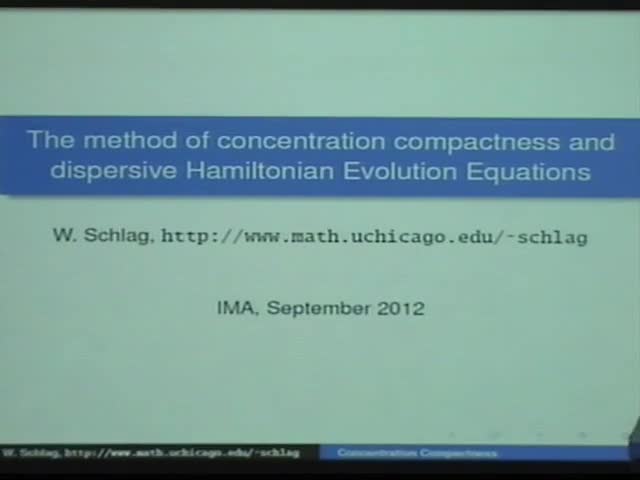Long-term dynamics for dispersive Hamiltonian evolution equations
Presenter
September 26, 2012
Keywords:
- Hamiltonian structures
MSC:
- 37K05
Abstract
This talk will survey some recent developments in the theory of nonlinear
dispersive evolution equations, with emphasis on a qualitative description of
the global-in-time dynamics of solutions. We will present the method of concentration compactness which has lead to important advances during the past
six years. These results cannot be obtained by perturbative techniques.
In the elliptic setting, concentration compactness was introduced into the
calculus of variations by P. L. Lions in the 1980s. The main idea is to exhibit
the action of non-compact symmetry groups as the only possible obstruction
to compactness. For evolution equations, such ideas were developed by Hajer
Bahouri and Patrick Gerard in the late 1990s, with independent work by Frank
Merle and Luis Vega at about the same time.
In 2006 Carlos Kenig and Frank Merle introduced a method into nonlinear
dispersive equations which allows one to obtain global existence and scattering
results for nonlinear evolution equations by means of a contradiction argument
based on induction on energy. Roughly speaking, the idea is to show that if
the desired result fails, then it does so at a minimal energy. Using concentration compactness, more precisely, a Bahouri-Gerard decomposition, one then
constructs a solution at that minimal energy with pre-compact trajectory in
the energy space. The fi
nal part of the argument, which is typically based on
virial-type identities, excludes the existence of such a rigid object.
This method has been applied to different classes of equations. In particular,
it was used in joint work with Joachim Krieger to establish global existence and
scattering for large data wave maps from 2+1 dimensions into hyperbolic space.
We will also present a qualitative description of the
flow of focusing nonlinear
wave-type equations at energies near the ground state energy. This latter work,
joint with Kenji Nakanishi, combines the theory of invariant manifolds in
this case generated by a ground state soliton with a one-dimensional exponential
instability in the linearized flow { with some of these concentration-compactness
and virial ideas, to exhibit a center-stable manifold as a surface separating an
open region of
finite-time blowup from another one leading to global existence
and scattering to a free wave. A crucial dynamical ingredient in this work is the
exclusion of almost homoclinic orbits associated with the ground state.
